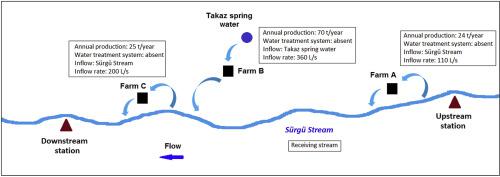Environmental Pollution ( IF 8.9 ) Pub Date : 2020-06-29 , DOI: 10.1016/j.envpol.2020.115101 Memet Varol 1 , Mustafa Balcı 2

|
In this study, characteristics of effluents from three flow-through rainbow trout farms in Turkey and their impact on water quality and epilithic algal communities of the receiving stream were investigated. Water samples were taken monthly from both inlets and outlets of three fish farms, while both water and epilithic algae samples were collected from two stations (upstream and downstream) in the stream. A significant increase from inlets to outlets was observed for chemical oxygen demand (COD), soluble reactive phosphorus (SRP), total suspended solids (TSS), NH4–N and total phosphorus (TP) (p < 0.05) due to no effluent treatment processes and high FCR at the fish farms. The daily average total nitrogen (TN) and TP fluxes of the fish farms predicted with the nutritional method were found close to those measured with the hydrological method. Although there were significant increases in COD, TSS, NH4–N, TN, NO3–N, NO2–N, TP and SRP concentrations at the downstream station compared to the upstream station of the receiving stream (p < 0.05), water quality of the downstream station remained in Class I in terms of examined parameters. Trophic Diatomic Index and Biological Diatom Index values indicated that the upstream station had a better water quality than the downstream station. Also, filamentous algae such as Cladophora glomerata, Ulothrix zonata and Stigeoclonium lubricum were observed at the downstream station. In view of the above findings, several suggestions were put forward to protect the water quality of the receiving stream.
中文翻译:

鳟鱼养殖场的出水特性及其对接收流水质和底栖藻类组合的影响。
在这项研究中,调查了土耳其三个流经虹鳟鱼养殖场的废水的特性及其对接收水的水质和石器藻类群落的影响。每月从三个养鱼场的进水口和出水口采集水样,同时从溪流中的两个站点(上游和下游)采集水和原石藻样品。从入口到出口的化学需氧量(COD),可溶性活性磷(SRP),总悬浮固体(TSS),NH 4 -N和总磷(TP)显着增加(p <0.05),因为在养鱼场没有污水处理工艺和较高的FCR。用营养方法预测的养鱼场的日平均总氮(TN)和总磷通量被发现与用水文方法测得的日均总氮和总磷通量接近。尽管与接收流的上游站相比,下游站的COD,TSS,NH 4 -N,TN,NO 3 -N,NO 2 -N,TP和SRP浓度显着增加(p <0.05),根据检查参数,下游站的水质仍保持在I级。营养硅藻指数和生物硅藻指数值表明上游站的水质优于下游站。另外,丝状藻类如在下游站观察到了球根枝柏,小叶乌贼和Stigeoclonium lubricum。鉴于上述发现,提出了一些保护接收流水质的建议。



























 京公网安备 11010802027423号
京公网安备 11010802027423号